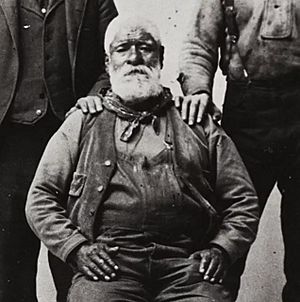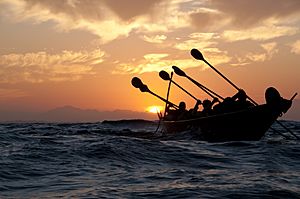Fernando Librado facts for kids
Quick facts for kids
Fernando Librado
|
|
|---|---|

Fernando Librado (circa 1912)
|
|
| Born | August 20, 1839 |
| Died | June 19, 1915 |
| Other names | Kitsepawit |
| Occupation | Master builder, craft specialist, philosopher, storyteller, elder |
| Known for | Knowledge of Chumash people, Indigenous experiences at Spanish missions in California, singing of Juana Maria's song |
Fernando Librado, also known as Kitsepawit, was an important Chumash elder. He was a master builder of special boats called tomols. He was also a wise storyteller and a skilled craftsman.
Fernando was born in 1839 at Mission San Buenaventura. His parents were both Chumash people from Limuw, which is now called Santa Cruz Island. He is famous for knowing a lot about Chumash culture and languages. He also shared stories about how Indigenous people lived during and after the Spanish missions in California. He worked with a researcher named John Peabody Harrington. Fernando even recorded a song by Juana Maria on a special wax cylinder.
Contents
Early Life and Family
Fernando's parents, Mamerto Yaguiahuit and Juana Alfonsa, were born on Limuw. The Spanish later called this place Santa Cruz Island. Mamerto was from the village of Nanawani. He was baptized in 1814 when he was two years old. Juana was from the village of Swaxil. She was baptized in 1816 at age five. Both were brought to Mission San Buenaventura as children. They got married on May 3, 1830.
Fernando was born on August 20, 1839. He was the fifth child of Mamerto and Juana. Sadly, all four of his older siblings had died as babies. Fernando was baptized at Mission San Buenaventura. He was part of the third generation of Chumash people. This means his family had lived through the changes brought by European contact.
His father, Mamerto, died on October 28, 1840, just a year after Fernando was born.
Growing Up and Learning
Fernando Librado grew up at Mission La Purísima. He paid close attention to the stories and knowledge shared by the older Chumash people. This knowledge later became very important for understanding Chumash history. Much of what he learned was written down by the anthropologist J.P. Harrington.
As a young boy, Fernando saw the last original tomols. These were traditional Chumash plank boats built before Europeans arrived. Seeing them was important for his later work in rebuilding these boats. When he was fourteen, he ran away from Ventura with another boy named Simplicio Pico.
In 1856, at age eighteen, a newspaper listed Fernando as a worker. He worked at a ranch called La Espada. Another worker there was Ramon, whom Fernando called his "uncle." Ramon was also of Island Chumash descent. This Ramon was actually Ramon Malo, who owned Mission La Purísima from 1845 until he died in 1859.
The La Espada ranch was known by its old Chumash village name, Shilimaqshtush. Another Chumash man named Konoyo, also called Silverio, taught Fernando a lot about building tomols. Konoyo was from Wi'ma, which is now Santa Rosa Island. Fernando used this knowledge later in his life.
Later Life and Contributions

From about 1880, when he was 41, Fernando Librado lived in Lompoc and Las Cruces, California. He lived in a small cave in the mountains near Santa Barbara. You had to crouch to get into the cave, but once inside, you could stand up. He might have gotten the name Librado, meaning "book lover," because he was a very good reader.
From his cave, Librado worked at a local ranch. He was a craftsman, a shepherd, a midwife, and a medicine man. Many people in the area knew him well. Sometimes, he would visit Tranquillon Mountain, which is now part of the Vandenberg Space Force Base. He went there to gather medicinal plants that grew in the area.
In 1912, Librado helped direct the rebuilding of a tomol. He called these boats the "house of the sea." This was a real wooden plank canoe. It was built using the knowledge he learned from Konoyo. In the same year, many photos were taken of Librado. These photos showed him building and crafting things. This proves how much he knew as a builder and specialist.
Starting in 1912, he worked a lot with John Peabody Harrington. Librado shared his vast knowledge, stories, and memories. This included stories about Indigenous experiences at the missions. He shared tales of resistance against mission authority that had been passed down to him. He also shared much about the Brotherhood of the Canoe and Chumash boats.
In 1913, he sang Juana Maria's song, called Toki Toki. This song was recorded on a wax cylinder. Librado had learned this song from Melquiades, a Chumash man. Melquiades had first heard Juana Maria sing the song in 1853.
Lasting Legacy
Fernando Librado died in 1915 at Santa Barbara's Cottage Hospital. He passed on a great deal of knowledge about Chumash culture and ways of life. His stories and work are featured in many books and articles today.
His work in rebuilding the tomol has inspired a new generation. The Chumash people have brought back the tradition of building tomols. They also paddle them out to the islands off California's coast. In 2022, the 20th annual trip was made from Santa Barbara, California to Limuw using a tomol.
Images for kids




